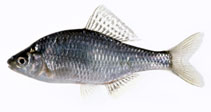| Family: |
Acheilognathidae (Bitterlings) |
| Max. size: |
7.93 cm SL (male/unsexed) |
| Environment: |
benthopelagic; freshwater; brackish; depth range - 40 m |
| Distribution: |
Asia: Japan. Five subspecies were recognized: Acheilognathus tabira erythropterus Pacific Ocean side of eastern Honshu (Miyagi, Tochigi, Ibaraki, Chiba Prefectures and Tokyo Metropolis); Acheilognathus tabira jordani in Japan Sea side of western Honshu (Toyama, Ishikawa, Fukui, Tottori and Shimane Prefectures); Acheilognathus tabira nakamurae in Kyushu area; Acheilognathus tabira tabira in Western Honshu; and Acheilognathus tabira tohokuensis in Japan Sea side of eastern Honshu (Akita, Yamagata, Fukushima in western area and Niigata Prefectures). |
| Diagnosis: |
Dorsal soft rays (total): 11-14; Anal soft rays: 11-13; Vertebrae: 35-38. Can be diagnosed by having the following characters: dorsal fin with iii, 9-11 rays; anal fin with iii, 9-10 rays; dorsal fin in males grayish; anal fin in nuptial males white; absence of black blotch on dorsal fin in juveniles; eggs short ellipsoid, ratio of major axis to minor axis, 1.4-1.7 (Ref. 78070).
Description: D iii,9-11; A iii,8-10; P i+ 14-16; V i+7 (Ref. 78070). |
| Biology: |
Inhabits rivers, creeks, lakes and ponds in plains. Also occurs in mouths of rivers draining into lagoons, in rocky shores of rivers and irrigation creeks, and in floodplain pools. Deposits its eggs into host mussels (Ref. 78070). |
| IUCN Red List Status: |
Near Threatened (NT); Date assessed: 08 December 2017 (B2ab(i,ii,iii,iv,v)) Ref. (130435)
|
| Threat to humans: |
harmless |
Source and more info: www.fishbase.org. For personal, classroom, and other internal use only. Not for publication.

